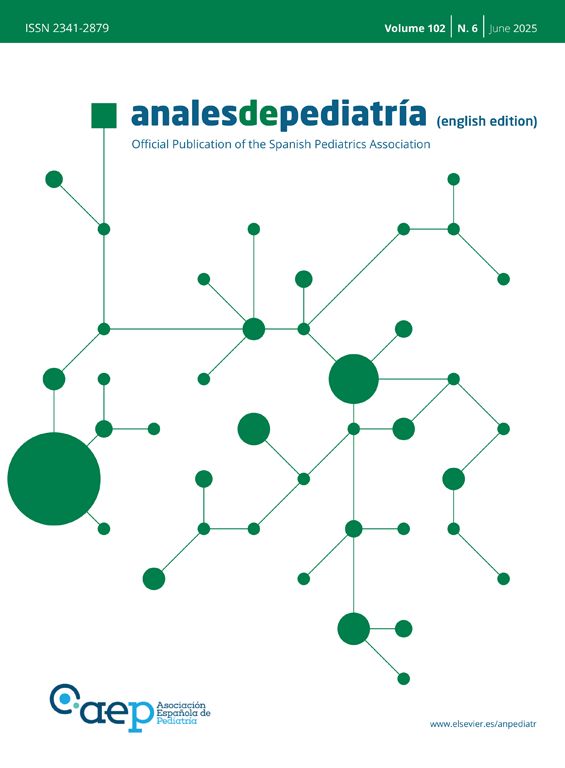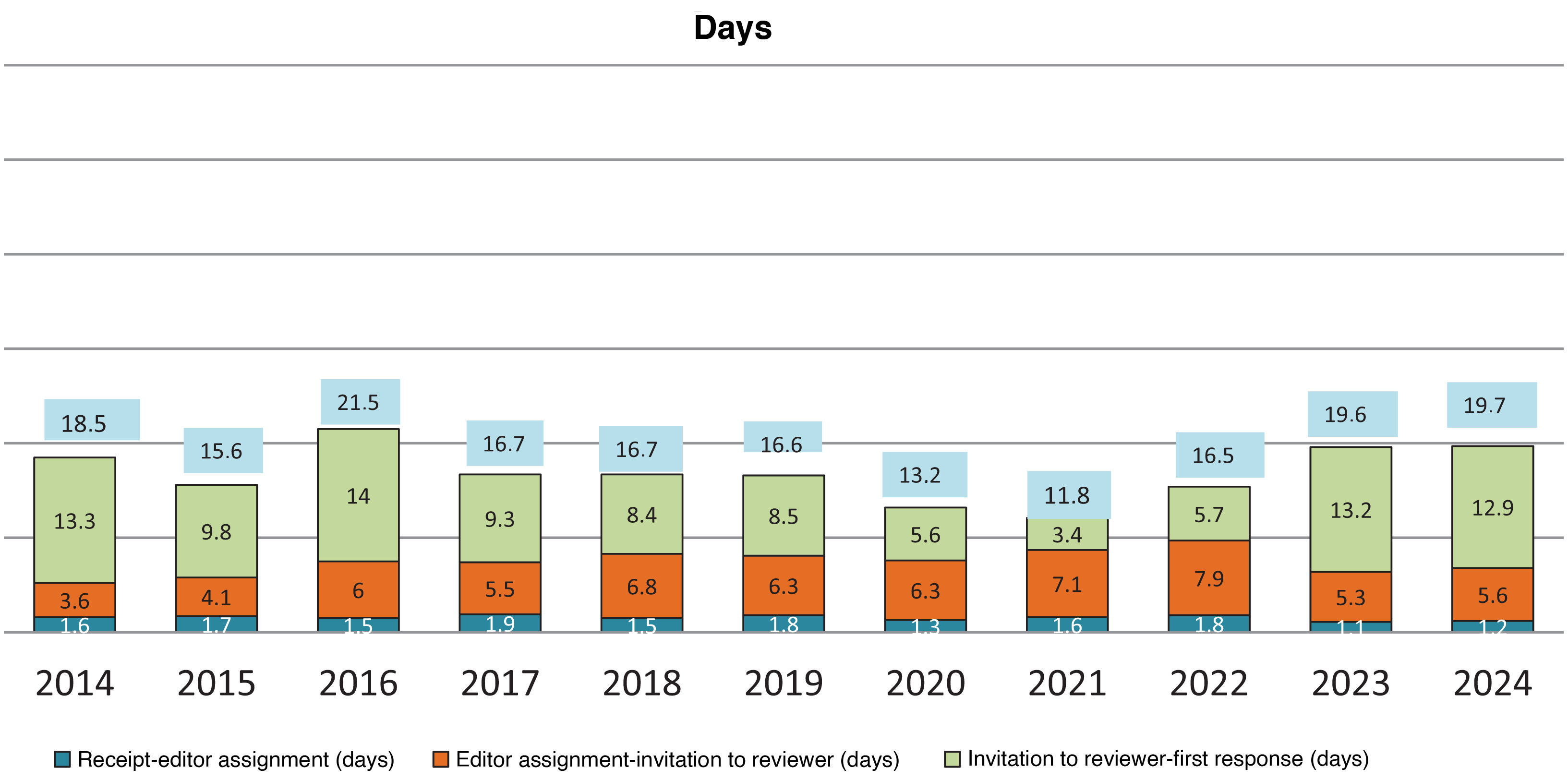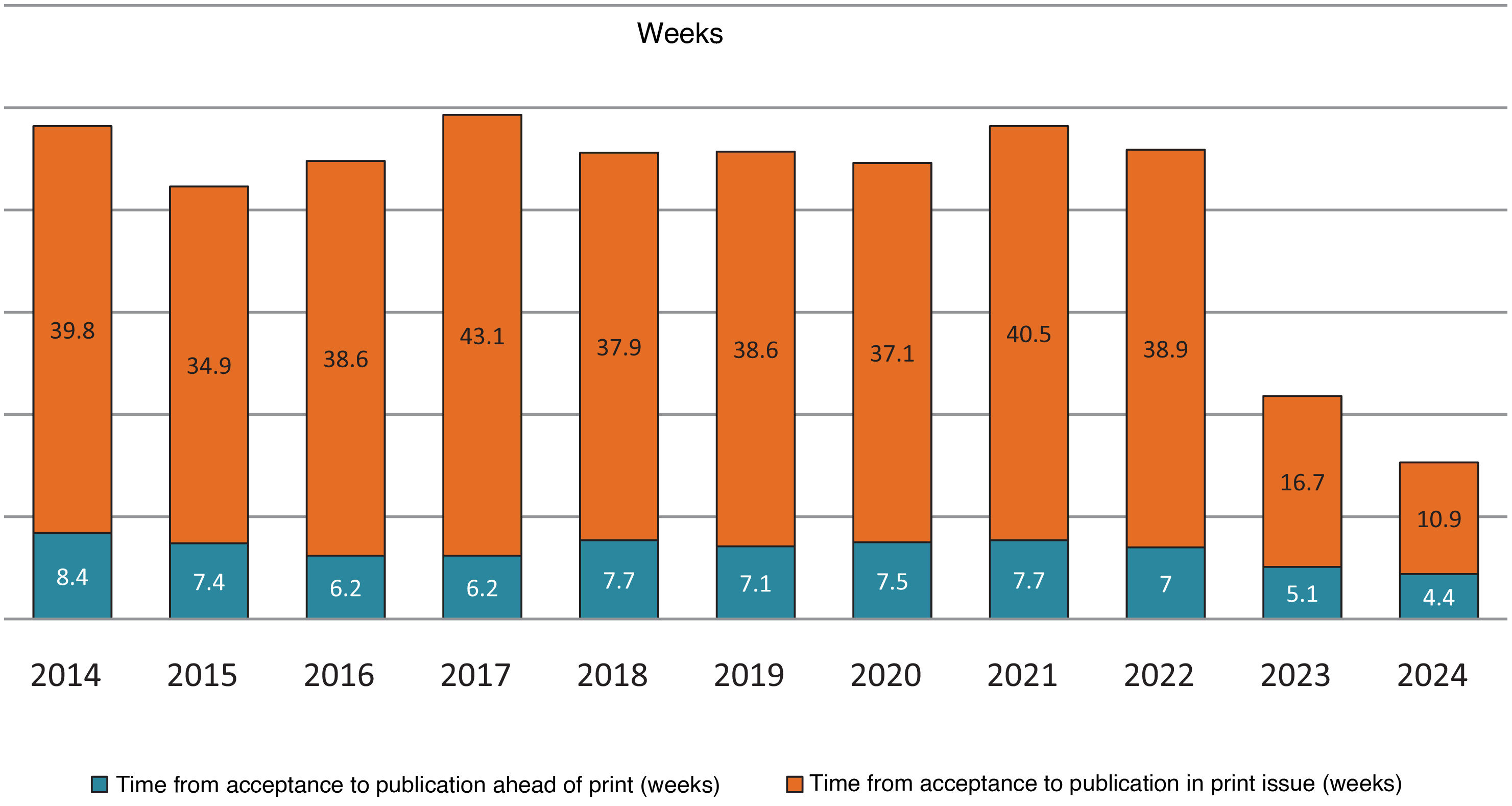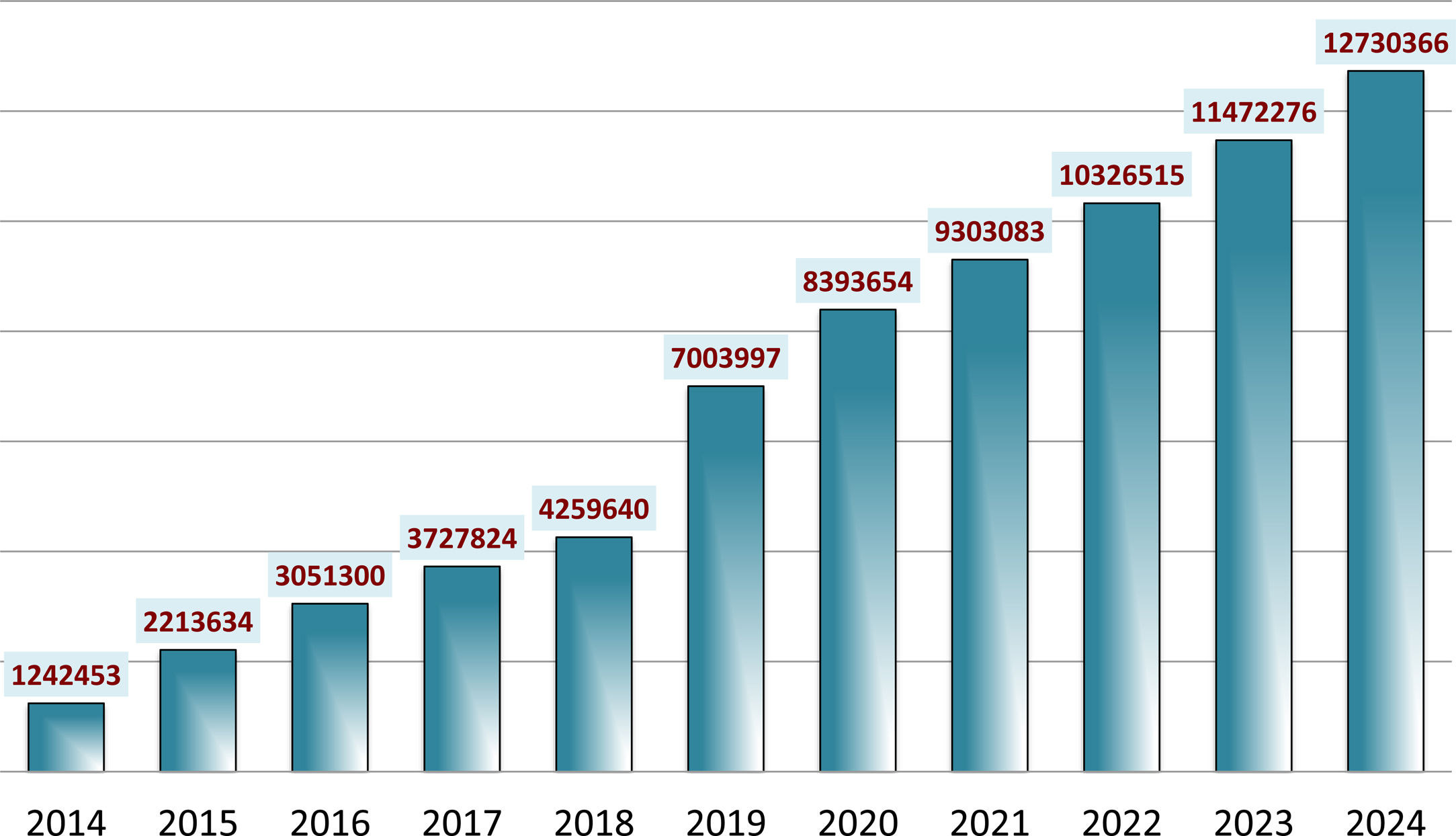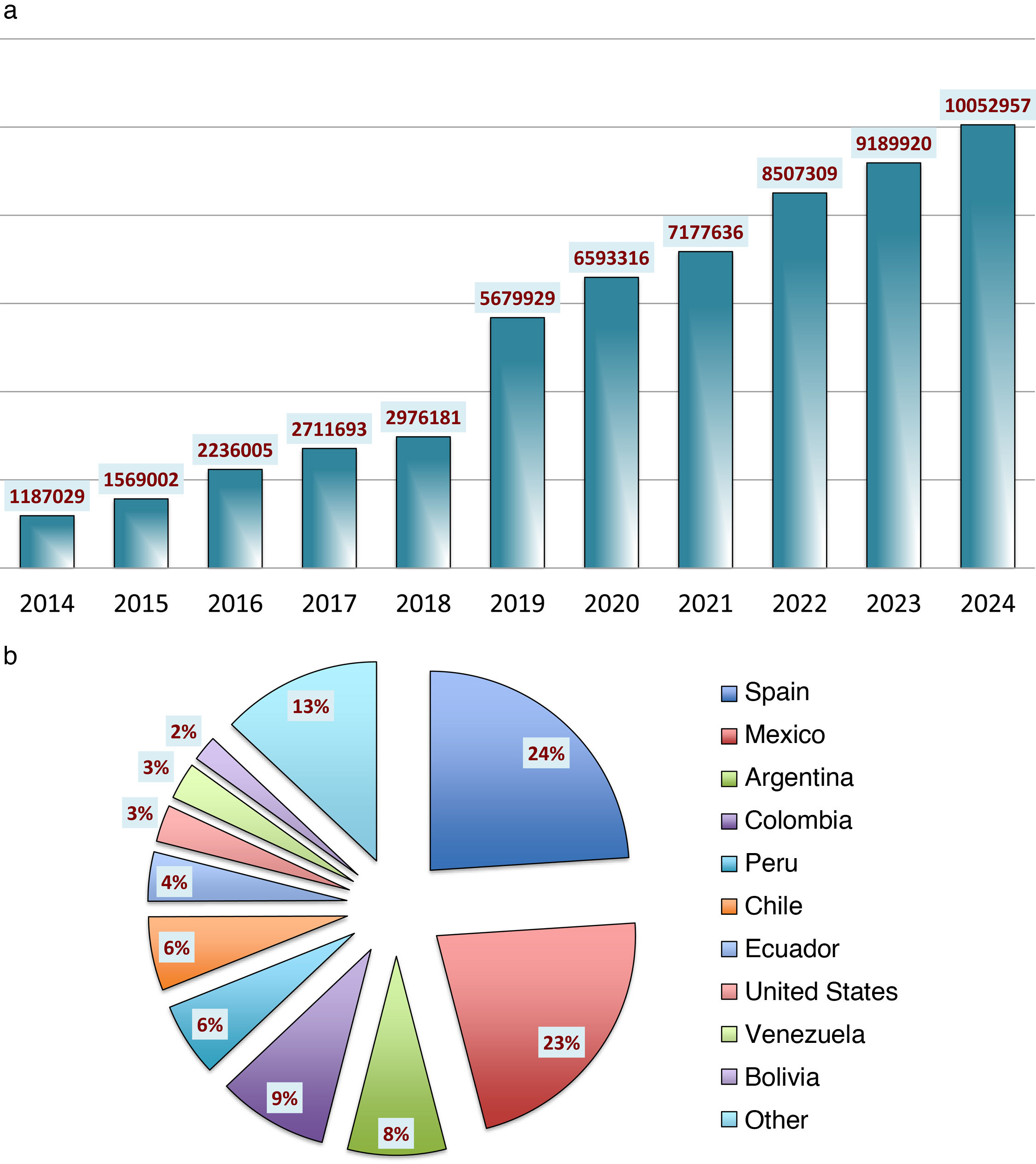One more year, the Editorial Committee of Anales de Pediatría shares the most relevant aspects of the journal through its annual report. In 2024, the number of articles submitted to the journal stabilized. We have maintained the dynamic approach to the editorial process, adjusting the contents of each issue and succeeding in further reducing editorial times. Anales de Pediatría was positioned in the second quartile of the 186 journals of its category in the Journal Citation Report 2023, and its visibility increased, with the number of visits exceeding 12 million.
Online monographic issuesThe Editorial Committee successfully launched three special online issues devoted to fields of growing scientific interest and relevance: genetics, child and adolescent psychiatry and research methodology, each comprised of six special articles.
This editorial strategy, supported by Elsevier, aims to respond to the need for up-to-date information in emerging fields in pediatrics and to increase the international visibility of the journal by reinforcing its standing in subjects of global interest.
Each monographic issue gathers a selection of special articles published in different regular issues of Anales de Pediatría. This format offers readers a cohesive, easily accessible thematic dossier on areas of interest and increases the visibility of articles by bringing them together under a common theme, which is also prominently featured on the publishing platform. At the same time, it adds flexibility to the management of articles without disrupting the established editorial schedule. All articles in special online issues are indexed individually and retain their original citability.
The three selected subjects correspond to strategic priorities identified by the Editorial Committee. Genetics is a cross-cutting research area in many fields of pediatrics that has a growing impact on diagnosis, prognosis and treatment and is experiencing rapid scientific and technological advances. The increase in mental health problems in the pediatric population and the limited training of health care professionals in this field evince the urgency to disseminate new knowledge in child and adolescent psychiatry. Finally, improving knowledge on research methodology is key to strengthening the quality of scientific output and fostering a culture of critical thinking among our readers.
Each special issue has featured guest editors, all renowned experts in their fields, who played a key role in selecting the topics for each issue, proposing authors recognized at the national and international levels, and managing the editorial process for the manuscripts (preliminary evaluation, proposal of peer reviewers and editorial decision-making). From the Editorial Committee, we would like to take this opportunity to express our gratitude for their commitment, rigor, dedication, and leadership, which have been instrumental in ensuring scientific quality and contributing to the success of this initiative. We would also like to thank the authors who have contributed to the special online issues with high-quality work, adhering to the required deadlines and standards.
With this editorial strategy, we reaffirm our commitment to excellence, current scientific knowledge and the service to the pediatrics scientific community.
Anales de Pediatría Q2. Thank youThe Editorial Committee continues to invest on strategies to improve the appeal of the journal through the dissemination from the Asociación Española de Pediatría (AEP) of an infographic and a video with the message “Anales de Pediatría Q2. Thank you” (Fig. 1). Their contents highlight the improvement in the impact of the journal, which reached the second quartile in 2023, and thanks authors and reviewers for their contributions.
Manuscript processingThe number of manuscripts submitted to the journal in 2024 was 663, of which 54% were original or special articles, with the percentage of scientific letters (24%) and images (18%) remaining similar to previous years. The rejection rate was 70% overall and reached 78% for original articles (Figs. 2 and 3).
The dynamic management of the manuscripts has achieved a reduction in processing times, with a mean time elapsed from reception to first response of approximately 20 days, a record time of 4 weeks from acceptance to online publication and 11 weeks to assignation to a journal issue. All the editorial processing times are currently in the optimal range and showing decreasing trends, and we have also managed to reduce the peer reviewer response time to fewer than 13 days (Figs. 4 and 5). In spite of the strategies implemented by the Editorial Committee, there is still considerable margin for improvement in the time to assignation and response of peer reviewers. It is a veritable challenge to find experts in the subject of each of the manuscripts willing to accept the invitation to participate in the peer review process, as we discuss further down.
Visibility metrics continue to improve each year, with visits to the journal currently exceeding 12 million and increases in the number of visits through both ScienceDirect and the website of Anales de Pediatría (Figs. 6 and 7). The most read article in 2024, with 92 508 was “The Relationship Between Parental Awareness of Sexual Abuse and Children’s Skills to Say No” by Kirbaş and Şahin, published in the March issue.1
(a) Visibility of Anales de Pediatría: Number of visits to the site (www.analesdepediatria.org) (years 2014–2024). (b) Percentage distribution by country was: Spain, 24%; Mexico, 23%; Colombia, 9%; Argentina, 8%; Peru, 6%; Chile, 6%; Ecuador, 4%; Venezuela, 3%; United States, 3%; Bolivia, 2%; and other countries, 13%.
We continued our activity through the social media accounts of the AEP with the daily posting of articles in X and monthly posting of the contents of each issue of the journal. The publication that achieved the greatest engagement (13.49 thousand reactions) was “Inhaled Medications and Inhalation Chambers for Childhood Asthma. Spanish Network of Working Groups on Asthma in Pediatrics (REGAP)” by Juliá Benito et al.,2 an article of the AEP that featured tables with information about inhaled medications and inhalation chambers frequently used in the management of asthma. The active presence of Anales de Pediatría in the social media accounts of the AEP is a strategic element for increasing its visibility and revitalizing the role of scientific knowledge in society. This novel vehicle for accessing scientific knowledge does not replace conventional channels, but rather supplements them, enriching them with visual formats and brief contents.
Impact factorFollowing the changes made to the metric calculation methodology of the Science Citation Index-Journal Citation Reports of the Web of Knowledge, the impact factor of Anales de Pediatría has continued on an overall decreasing trend, with a value of 1.5 in 2023, although it was positioned in the second quartile for the first time, thereby improving its ranking despite the decrease in the impact factor for reasons discussed in last year’s editorial.3 At the time of this writing, we do not yet know the impact factor for 2024 and prefer to err on the side of caution and refrain from making predictions.
ReviewersAs can be seen in Table 1, a total of 537 expert reviewers participated in the journal, to whom we thank one more year for their altruistic work, which is the cornerstone of peer review. One of the greatest challenges of the Editorial Committee is the identification and recruitment of ideal reviewers for each manuscript, as they need not only have the scientific expertise but also the available time and disposition to collaborate in the peer review process on a voluntary basis. The countless requests for peer reviews that researchers receive is clearly overwhelming, especially in those who are most specialized, which explains the increasing frequency with which experts decline or do not respond to peer-review invitations. This situation is exacerbated when the manuscript pertains to a highly specific niche. Furthermore, out of respect and professional deference, we choose to send invitations sequentially, that is, approaching potential reviewers one by one and waiting for their response before moving on to the next invitation. Although this practice prioritizes respect for reviewers, it has the direct consequence of significantly extending editorial times. The Editorial Committee has expanded its pool of reviewers thanks to the AEP, its affiliated regional and specialty scientific societies and its working groups. We have explicitly acknowledged the work of peer reviewers in the annual report of the editors and have negotiated the free registration for a Continuum course on behalf of the AEP as a token of appreciation. As editors, we want to promote a sense of shared responsibility among authors and peer reviewers in their participation in maintaining the balance of the publishing ecosystem.
Professionals who have collaborated as peer reviewers with Anales de Pediatría in 2024.
| First name | Last name |
|---|---|
| Isabel | Abadías Granado |
| Juan Carlos | Abril |
| Víctor | Adán Lanceta |
| Marta | Aguar |
| Pedro | Agudo Montore |
| Sergio | Aguilera-Albesa |
| David | Aguilera-Alonso |
| Helena | Alarcón Martínez |
| María Rosa | Albañil Ballesteros |
| M. Salome | Albi-Rodriguez |
| Pedro J. | Alcalá Minagorre |
| Rosa | Alcobendas |
| Alexandra | Aldana Grisales |
| Victor | Alegre |
| Iciar | Alfonso |
| Xavier | Allue |
| Andrés Fernando | Almario-Hernández |
| José M. | Almerich |
| Veronica | Alonso |
| José Lorenzo | Alonso Calderón |
| Almudena | Alonso Ojembarrena |
| Paula | Alonso Quintela |
| José Antonio | Alonso-Cadenas |
| Laia | Alsina Manrique de Lara |
| Ignacio | Alvarez Alvarez |
| Guillermo | Álvarez Calatayud |
| Francisco José | Álvarez García |
| Víctor | Álvarez Muñoz |
| Fernando | Álvez |
| Ana Gloria | Andrés |
| Jesús María | Andrés Llano |
| Anselmo | Andres Martin |
| Juan L. | Antón-Pacheco |
| Rosa Patricia | Arias Llorente |
| Juan | Arnaez |
| Javier | Arredondo Montero |
| Ignacio | Arroyo Carrera |
| Luis | Arruza |
| Javier | Ayala Curiel |
| María Cristina | Azcona |
| Beatriz | Azkunaga |
| María | Azpilicueta-Idarreta |
| Albert | Balaguer |
| Elena María | Balmaseda Serrano |
| Fernando | Baquero Artigao |
| Ester | Barrios |
| Isabel | Belinchón Romero |
| Ana | Bergua |
| Sara | Berrade |
| Isabel | Betlloch |
| Alfredo | Blanco Quirós |
| Miriam | Blanco Rodríguez |
| Andrés | Bodas Pinedo |
| Alejandro | Bosch Alcaraz |
| María Carmen | Bravo |
| Juan | Bravo Acuña |
| José-Rafael | Bretón |
| Jesús | Broto Mangues |
| Gloria | Bueno Lozano |
| Guillermo | Burillo-Putze |
| Laura | Butragueño Laiseca |
| María Josep | Cabañas |
| Cristina | Calvo |
| Fátima | Camba Longueira |
| Francisco José | Cambra Lasaosa |
| Minia | Campos Domínguez |
| Alfredo | Cano |
| Roque | Cardona-Hernández |
| Sonia | Caserío |
| Raquel | Castañeda Mendieta |
| Félix | Castillo Salinas |
| Fernando | Centeno-Malfaz |
| M. José | Cilleruelo Ortega |
| Francisco José | Climent Alcalá |
| Antonio José | Conejo-Fernández |
| Beatriz | Corredor-Andrés |
| Marta | Costa-Romero |
| María L. | Couce |
| José Antonio | Couceiro Gianzo |
| Pilar Adelaida | Crespo Suarez |
| Borja | Croche Santander |
| Ofelia | Cruz Martínez |
| Marta | Cruz-Cañete |
| Juan Carlos | de Carlos Vicente |
| Cristina | de Manuel Gómez |
| Iñigo | de Noriega Echevarría |
| Elena | del Castillo Navío |
| Teresa | del Moral |
| Jesús | del Pozo Losada |
| Carlos | Delgado-Miguel |
| Isabel | Delgado-Pecellín |
| Ana María | Diaz Vico |
| Ignacio | Díez López |
| Azucena | Diez-Suárez |
| Enric | Duran Taulería |
| Iñaki | Eizaguirre |
| Carla | Escribano García |
| Raquel | Escrig Fernández |
| Montse | Esquerda |
| Manuel A. | Fernández |
| Francisco | Fernández Carrión |
| Belén | Fernández Colomer |
| Porfirio | Fernández González |
| Inmaculada | Fernández Jiménez |
| José Luis | Fernández Trisac |
| José | Fernández-Cantalejo |
| María | Fernández-Ibieta |
| Ana | Fernández-Teijeiro |
| Marta | Ferrer-Lozano |
| Josep | Figueras-Aloy |
| Joan | Figuerola |
| Jesús Alberto | Fuentes Carballal |
| Enrique | Galán |
| Gonzalo | Galicia Poblet |
| Marta Taida | García Ascaso |
| María Asunción | García Pérez |
| Araceli | García Pose |
| Mercedes | García Reymundo |
| Adrián | García Ron |
| Patricia | García Soler |
| Alfredo | García-Alix |
| Juan Pablo | García-Iñiguez |
| Fermín | García-Muñoz Rodrigo |
| Víctor Manuel | García-Nieto |
| Ignacio | García-Núñez |
| Alberto | García-Salido |
| José Ignacio | Garrido Pérez |
| Javier | Gil Antón |
| María Ángeles | Gil Lemus |
| Marta | Gómez Chiari |
| José Andrés | Gómez del Barrio |
| Andrés | Gómez Fraile |
| Esteban | Gómez Sánchez |
| Manuel | Gómez Tellado |
| Javier Ricardo | Gómez Veiras |
| María | González Balenciaga |
| María Teresa | González Campillo |
| Jesús | González de Buitrago Amigo |
| Rafael | González de Caldas Marchal |
| L. Ignacio | González-Granado |
| Walter Alfredo | Goycochea-Valdivia |
| José Lorenzo | Guerra Díez |
| Ángel Antonio | Hernández Borges |
| Ramón | Hernández Rastrollo |
| Ángeles | Herrador Montiel |
| Blanca | Herrero Velasco |
| Francisco | Hijano |
| Belén | Huidobro Fernandez |
| Kristina | Ibañez |
| Ignacio | Ibarra |
| Ainhoa | Iceta-Lizarraga |
| Martin | Iriondo |
| Moisés | Labrador-Horrillo |
| Laura | Lacomba-Trejo |
| María Dolores | Lanzarote-Fernández |
| Juan José | Lasarte |
| María | Legarda-Tamara |
| Adrián | Llerana |
| Ana | Lobeiras Tuñón |
| José Domingo | López Castilla |
| Juan Alonso | López-Andreu |
| Jesús | López-Herce |
| David | Lozano Díaz |
| Carles | Luaces-Cubells |
| Adriana | Machinena Spera |
| Leire | Madariaga |
| Alfredo | Marco |
| Catalina | Márquez Vega |
| María Dolores | Marrodán |
| Carmen | Martínez |
| Pablo | Martínez Camblor |
| Teresa | Martínez Menchón |
| Santiago | Martínez-Isasi |
| Jose | Martinez-Orgado |
| Ricardo | Martino Alba |
| José Manuel | Marugan Miguelsanz |
| Cristina | Mata Fernández |
| Daniel | Mata Zubillaga |
| Miguel | Mayo Yañez |
| Marta | Melgosa Hijosa |
| Beatriz | Mercader |
| Santiago | Mintegi |
| Concepción | Mir Perelló |
| Carmen | Miranda Cid |
| Vicent | Modesto i Alapont |
| Miguel Ángel | Molina Gutiérrez |
| Olga | Monteagudo |
| Abián | Montesdeoca Melián |
| Néstor | Montoro Pérez |
| Fernando | Moraga Llop |
| Ana | Moráis |
| Ana | Moreno-Alvarez |
| Antonio | Moreno-Galdó |
| María | Navalon Rubio |
| Rosario | Navarret Ros |
| Lucía | Navarro |
| Álvaro | Navarro Mingorance |
| Víctor Manuel | Navas-López |
| Esmeralda | Núñez Cuadros |
| Gemma | Ochando Perales |
| Flor Ángel | Ordóñez Álvarez |
| Gloria | Orejón de Luna |
| Pedro José | Ortega López |
| Juan Antonio | Ortega-García |
| Roberto | Ortiz Movilla |
| Lucía | Ortiz San Román |
| Luis | Ortiz-González |
| Carmen Rosa | Pallas-Alonso |
| Enrique | Palomo |
| Alberto | Parente |
| Rocío | Paricio del Castillo |
| Anna | Parra-Llorca |
| Julio | Parrilla Parrilla |
| María José | Peláez Cantero |
| David José | Peláez Mata |
| Rocío Alejandra | Peña-Juárez |
| Alejandro | Pérez-Muñuzuri |
| Mirella | Piera Gaboli |
| Mercè | Pineda |
| Mari Carmen | Pinedo |
| Roser | Porta Ribera |
| Marcos | Prada Arias |
| Pablo | Prieto-Matos |
| Feliciano J. | Ramos |
| José Miguel | Ramos-Fernández |
| María Consuelo | Revert Girones |
| Corsino | Rey |
| Susana Beatriz | Reyes |
| Isolina | Riaño Galán |
| Segundo | Rite Gracia |
| María del Carmen | Rivero de la Rosa |
| Carlos | Rodrigo |
| Amparo | Rodríguez |
| Silvia | Rodríguez Blanco |
| Pedro Javier | Rodríguez Hernández |
| Antonio | Rodríguez Núñez |
| Alejandro | Rodríguez Ogando |
| Alejandro | Rodríguez-Martínez |
| Pablo | Rojo |
| Enriqueta | Román |
| Fernando | Rueda Núñez |
| Ricardo | Ruiz Villaverde |
| José Manuel | Rumbao Aguirre |
| Jesús | Saavedra |
| Pilar | Sáenz |
| Frederic | Samson |
| Antonio | Sánchez Andrés |
| Jesús | Sánchez Echániz |
| Rafael | Sánchez Gutiérrez |
| Manuel | Sánchez Luna |
| Ana | Sánchez Torres |
| Fernando | Santos |
| Fernando | Santos-Simarro |
| Lucía | Sentchordi |
| Elena | Seoane Reula |
| María del Mar | Serrano Martin |
| Juan Pedro | Siguero |
| Marta | Soria López |
| Pilar | Storch-de-Gracia |
| María Carmen | Suárez-Arrabal |
| Marta | Suarez-Rodríguez |
| Andrea | Sucasas Alonso |
| Alfredo | Tagarro |
| M. Angeles | Tejero Hernández |
| Cristina | Toledo-Gotor |
| Sebastián | Tornero Patricio |
| Javier | Torres-Borrego |
| José | Uberos |
| Rolando | Ulloa-Gutierrez |
| Javier | Urbano |
| Laura | Valdesoiro Navarrete |
| Marta Esther | Vázquez Fernández |
| María Ángeles | Vázquez López |
| José Luis | Vázquez Martínez |
| Fernando | Vázquez Rueda |
| Francisco | Vela Enríquez |
| Roberto | Velasco |
| Marta | Velasco Rodríguez-Belvís |
| Máximo | Vento |
| Josefina | Vicente Rueda |
| Saioa | Vicente-Santamaría |
| Cristina | Vicho González |
| Juana María | Vidal Miñano |
| Susana | Viver Gómez |
| Miguel Ángel | Zafra Anta |
| Gonzalo | Zeballos Sarrato |
The names of professionals who reviewed more than 3 articles are presented in boldface.
We also thank the authors for their interest and trust in our journal. We work diligently in the management of each manuscript to ensure its quality, relevance, and contribution to the advancement of knowledge. Nevertheless, we apologize for any errors we may have made in each evaluation.
AwardsThe annual Anales de Pediatría 2025 award to the best article published by the journal in 2024 was given to the original article “Differences in the temporal trends of childhood overweight and obesity in Spain in the 2011–2019 period by sex, age and socioeconomic level: Results of the ALADINO study” by Gutiérrez-González et al.4 In 2025, the award to the article that has contributed the most to the impact factor ofAnales de Pediatría in the last two years was given to the original article “Self-injury and suicidal behavior in children and youth population: Learning from the pandemic” by Vázquez López et al.5 on behalf of the Working Group on Pediatric Mental Health of the AEP, the Sociedad de Psiquiatría Infantil, the Sociedad Española de Urgencias Pediátricas, the Asociación Española de Pediatría de Atención Primaria, the Sociedad Española de Pediatría Social and the Sociedad Española de Medicina de la Adolescencia.
On behalf of the Editorial Committee, we offer our congratulations to the authors of these articles.
As stated in the rules for the Anales de Pediatría 2025 award the jury also selects a second winner, who is placed on reserve and does not receive a cash prize. This year, the selected article was “Usefulness of virtual reality in the management of pain associated with venepuncture: a multicentre randomized clinical trial” by Gil Piquer et al.6 We would like to highlight the collaborative work of five primary care centers and two regional hospitals within the same health care area in the Valencian Community in the design and development of a multicenter randomized clinical trial of an innovative technological tool.
Asociación Española de PediatríaWe are grateful for the ongoing support of the Executive Board of the AEP to the activity of the Editorial Committee. It has been essential in the implementation of new editorial initiatives and in promoting the diffusion and visibility of the journal.
We would also like to express our appreciation to all those who, through their dedication and commitment, have made possible the growth and consolidation of Anales de Pediatría. We would especially like to thank the working groups, committees, and scientific societies of the AEP for their active participation as reviewers and authors who are authorities in their fields.
We would like to thank everyone for making this journal your own and contributing to its scientific quality and prestige.

